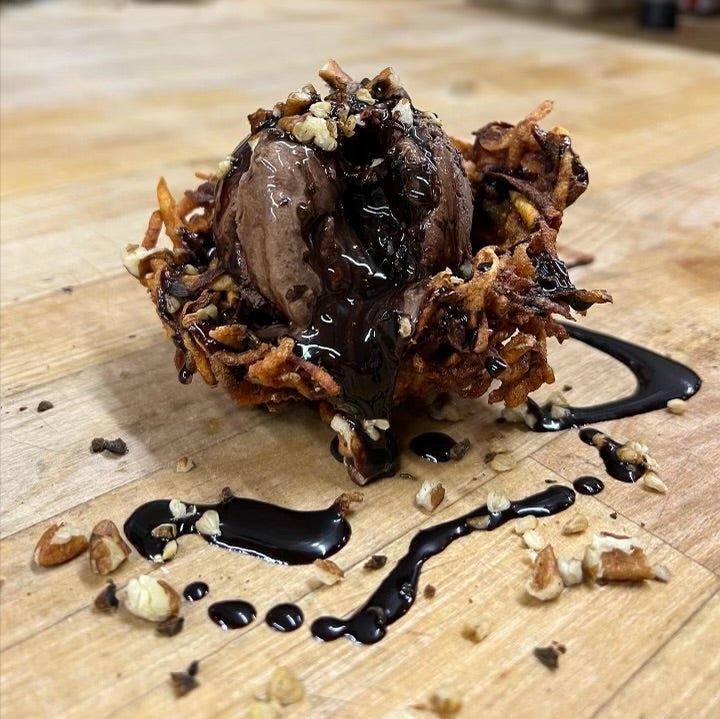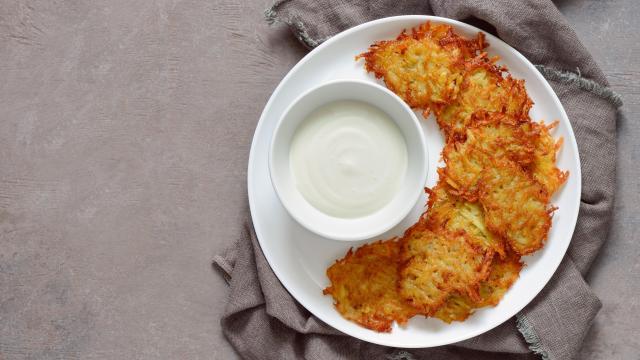Over two thousand years ago, a motley crew of Jews rebelled against their Greek occupiers and reclaimed the Second Temple in ancient Jerusalem. Later, some rabbis added an apocryphal tale to the event about oil lasting, as Adam Sandler would say, eight crazy nights. Today, we commemorate it all by eating fried potato pancakes called latkes.
It might seem like a stretch, but hey, it makes more sense than a human-sized rabbit handing out eggs on Easter, or someone dressed in Tim Allen cosplay flying around the world with magical reindeer to deliver presents to every child in a single night.
Traditionally, latkes are made of grated potatoes, onion, flour or starch, and an egg to bind it all together. But chef and professional Jewish sandwich slinger, Jeremy Umansky, is looking to change that. He’s making his latkes with just potatoes.
They tried to kill us, we survived, let’s eat
Umansky is the founder and chef of Larder Delicatessen & Bakery in Cleveland, Ohio — a James Beard nominee for Best New Restaurant in America in 2019. Food & Wine dubbed him “The Deli Prophet,” and a year later, he co-authored “Koji Alchemy,” a remarkable deep dive into the umami possibilities within Japanese fermentation.
This is all to say that Umansky is not shy when it comes to experimenting. So it’s no surprise that he’s trying to make latke sundaes a thing. Yes, you read that right. Latke. Sundaes.

Here’s why mixing fried potatoes with ice cream might sound a little strange on paper.
Potato latkes come out of the Eastern European, Ashkenazi Jewish tradition. Traditionally, you grate some potatoes and an onion, sprinkle in black pepper, mix them up with some flour or starch and an egg to bind it all together before slapping fist-fulls of the mix onto an oiled up skillet. Once they’re nicely browned on each side, the focus shifts to the age-old argument: Do you serve it with applesauce or sour cream? But these days, home cooks get creative and will throw just about everything on a latke from pizza toppings to a shakshuka-style egg. I’ll even mix in some plantain and refried blackbeans to make a latke patacone.
However you latke, the experience is generally a savoury one. But why not go sweet? Hanukkah falls into the “They tried to kill us, we survived, let’s eat” category of Jewish holidays. So truly, we can do whatever we want. That’s the mentality Chef Umansky brings to his latke sundae, and that’s why he recommends a potato-only approach
Making latkes sweet
It all started when Umansky wanted to make a latke that was only potato. “We didn’t want anything else in there,” he says. “No eggs, no flour, no other binders, no onion, no anything.”
The reason being, potato on its own can lean savoury or sweet. Think about it. Who among us hasn’t dipped a french fry into a milkshake? Returning the latke to its simplest form unlocks the other half of the flavour spectrum.
“Potato works very well, crossing over with some sweetness,” says Umansky. “So developing a latke that was just potato was important, because not all those [traditional] ingredients translate over.”
In other words, it’s hard to harmonise black pepper with chocolate ice cream.
Umansky doubles down on his sweet latke by pointing out how much latkes have evolved throughout Jewish history. Sicilian Jews had their Hanukkah fried pancake made from fermented batter, semolina, honey, and ricotta. The Spanish Inquisition (the Spaniards ruled Sicily at the time) kicked the Jews out and up to Eastern Europe where potatoes were far more prevalent. And voilà, the latke we know, lovetoday was born.
The modern day hash of potatoes, onions, maybe a little garlic, egg, and flour is the latke norm. Umansky acknowledges this. But nothing says we have to stick to that rulebook. We can make latkes the way we want to eat them.
At Larder in Cleveland, that means turning the latke into a fried potato bowl with a scoop of chocolate ice cream inside, chocolate sauce drizzled on top, and surrounding it all with walnuts and dried cranberries.
The only question is: What will your latke be this Hanukkah?
How to make a potato-only latke
You’re probably wondering how you get shredded potatoes to stick together without a binder. Remember, potatoes are full of starch — a binder in and of itself.
Umansky says he uses a par-cooking technique to gelatinize the starch inside of his potatoes. Par-cooking is a technique where you partially cook something with the intention of finishing it later. It’s popular for food prep and allows you to quickly heat something prior to serving. Umansky preheats his oven to 180°C, places the potatoes on a parchment-lined baking sheet, and lets them bake for 30 minutes. It’s only after they cool off that he’ll start running them against a box grater or putting them into a food processor.
This technique, Umansky explains, makes the flesh of the potato incredibly sticky, which is how he gets away with not using flour, eggs, or any other binder. He specifically uses a Carola potato for his potato-only latkes, because they’re an extremely buttery tasting potato with a creamy, waxy flesh. Plus, he can source them locally at the Shaker Square North Union Farmers Market in the Cleveland area. But a Carola substitute isn’t a deal breaker. Umansky stresses that you can use any potato you like.
At Larder, they prefer frying their latkes in either chicken or duck schmaltz, but Umansky says home cooks can use olive oil or really any oil of their choice. The ratio he uses is one pint of schmaltz or oil to two large Carola potatoes.
Any experienced latke line worker knows that you shape the potato mix into a fist-sized pancake on the skillet, maybe even giving it a little smush with the backside of a spatula. But as the owner of a deli, Umansky is making a lot of latkes this time of year. Efficiency and ease are key. That’s why he cuts his latkes into squares. It’s easier for him at the restaurant.
At the end of the day, fried potatoes are fried potatoes. They won’t taste differently whether they’re in a rough circular shape, a square, or a carefully crafted rhombus. Do whatever works for you and makes frying up your latkes a swift, smooth, and satisfying experience.

Leave a Reply
You must be logged in to post a comment.